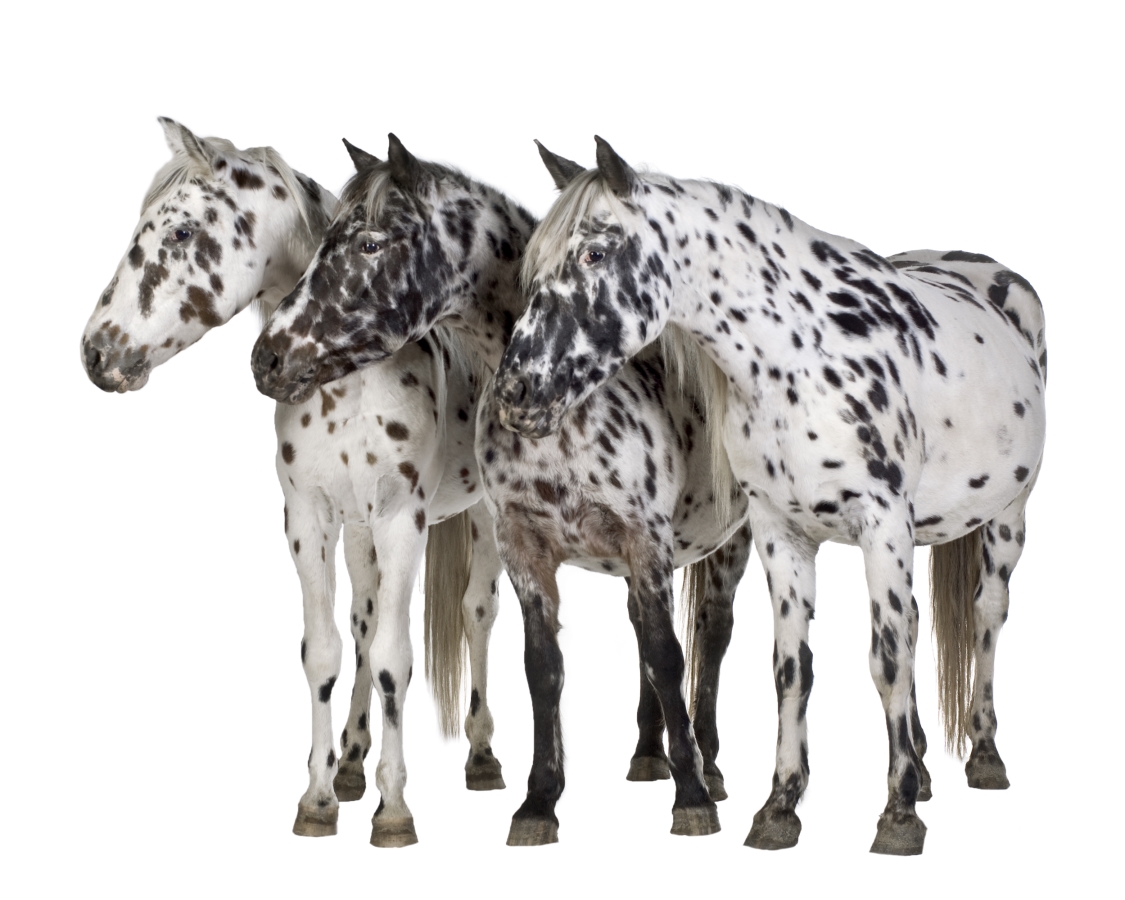Spotted horses are eye-catching and special. The coat patterns with spots are controlled by genetics and are inherited via the so-called Leopard factor also called the LP gene or Leopard complex. This article will take you through all the common spotted horse breeds as well as some less common and unusual ones.
- Spotted Horse - different types
- Spotted Horse Breeds
- Appaloosa
- American Miniature Horse
- Knabstruppers
- Pony of the Americas - POA
- Gypsy Cobs an Gypsy Vanners
- Mustang
- Welsh
- British spotted pony
- Colorado ranger
- Felin pony
- Noriker horse
- Falabella
- Gotland pony
- Spanish Spotted Saddle Horse
- Altai
- Kyrgyzstan horse
- Australian Spotted Pony
- Tuva Horse
- Tiger Horse
- Andalusian and Lucitano
- Paso Fino, Paso Tiger Horse or Atrigado Spanish Jennet Horse
- Walkaloosa
- Karabair horses
- South German Coldblood
- Breeds not allowed to be spotted but have the Leopard complex anyway
- Spotted Horse in different languages
- Disadvantages of spotted horses
- Conclusion
- Sources
Spotted Horse – different types
A spotted horse should not be confused with a pinto horse as they are completely different color types both in terms of appearance and genetics. A leopard och appaloosa colored horse can vary greatly in appearance. From a horse with white background with black spots to a dark horse with white spots. Here are the most common types of spotted horse patterns with Leopard complex:
| Blanket | a white area over the croup, sometimes called a snow cap. |
| Blanket with spots | a white area with spots in the horse’s basic color. |
| Leopard | an entirely white horse with well-defined darker spots. The spots are in the horse’s base color and can vary in number and size. The eyes often have white sclera. The skin around the eyes and muzzle is often pale and mottled. |
| Snowflake | a horse with white spots or flecks on a darker basic color. |
| Varnish or marble roan | progressive roaning with the absence of white hair over bony prominences such as limbs, facial crest, point of the hip, and point of the elbow. |
| Roan blanket | roaning over the hip and croup, with or without additional spots. |
Leopard complex
The Leopard Complex manifests itself in several ways shown in pictures below:
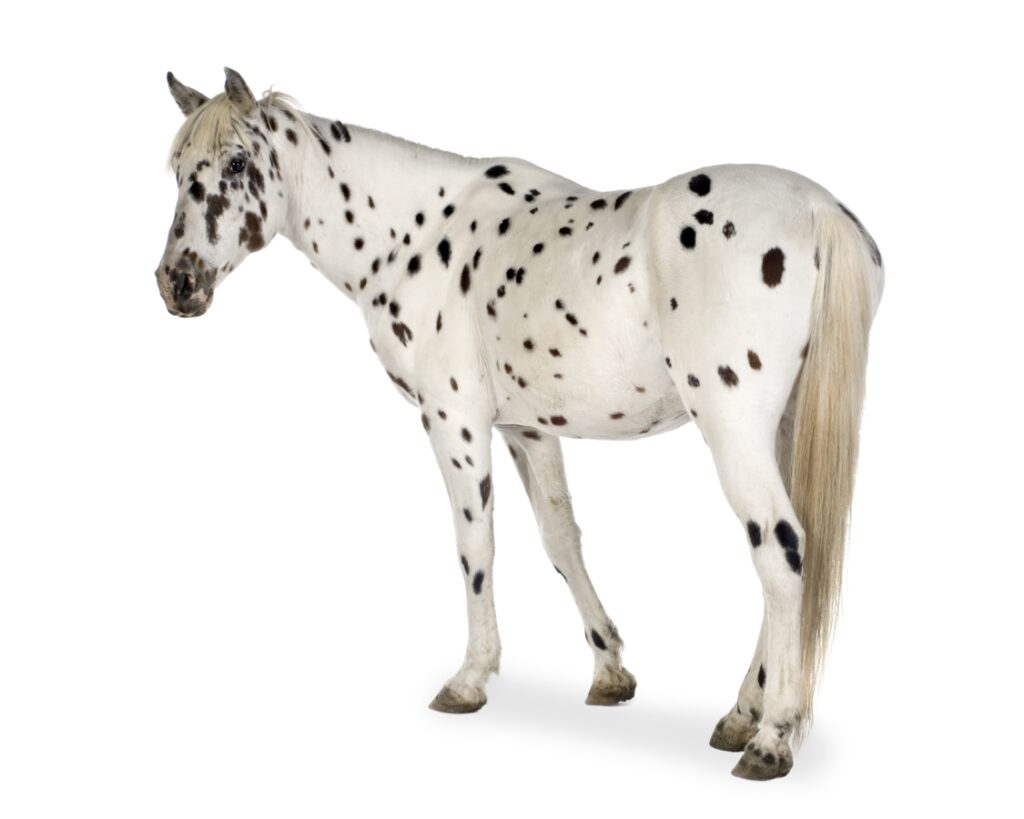

Photo: ©The Helpful Vet
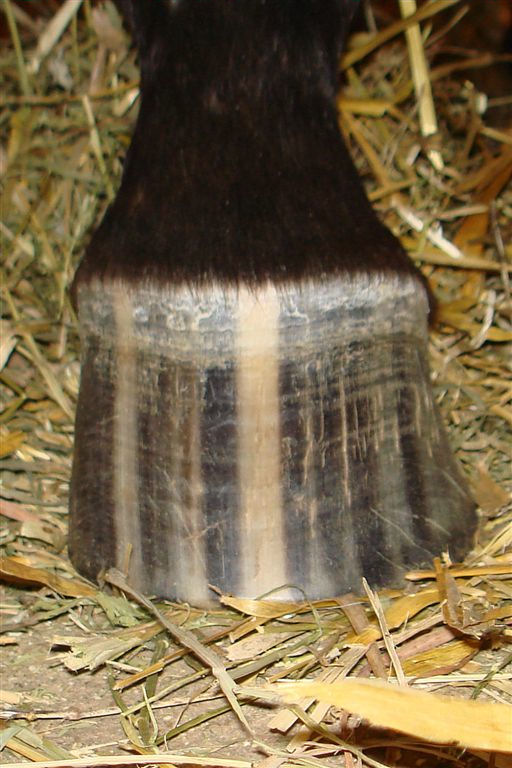
Photo: Saddlebrook Appaloosas is licensed under CC BY-SA 3.0 https://en.wikipedia.org/wiki/File:Stripedhooves.jpg
Other typical signs are white sclera in the eye and progressive roaning or loss of pigment in the coat.
Spotted Horse Breeds
According to studies, spotted horses, the leopard complex, have been found in several different breeds. Below is a list of breeds in which the leopard gene is present:
Appaloosa
The Appaloosa is native to the northeastern United States. Spanish horses were brought into North America via Mexico and spread north. By the early 18th century, the horses had reached the Nez-percé native American country in the northeastern United States (parts of Oregon, Washington, and Idaho). The area was well suited to horse breeding and the Nez Perce people produced a riding horse adapted to mountainous and hilly terrain sometimes called the Nez Perce horse. The horses were raised along the Palouse River and so began to be called “A Palouse Horse” by the settlers. Later this gradually changed to the Appaloosa horse. During the war of 1877, almost all the native American horses were killed and the breed was in danger of extinction. But in the early 20th century, interest in western horses was revived and the Appaloosa Horse Club was formed in 1938 to promote the breeding. The Appaloosa officially became a breed in 1950. Today the horse is used as a ranch horse and in western sports and is one of the most common spotted horse breeds.

Photo: “Leopard Appaloosa Horse.” by gailhampshire is licensed under CC BY 2.0.
American Miniature Horse
American Miniature Horses were created with the breeding goal: To produce the smallest possible perfect horse. Horses must not be taller than 34 inches at the withers (measured at the last hair of the mane). All colors, patterns, and markings as well as eye colors are permitted. They make excellent companion animals but are usually too small to be used for horseback riding. The leopard pattern is a common color pattern in these beautiful little horses.
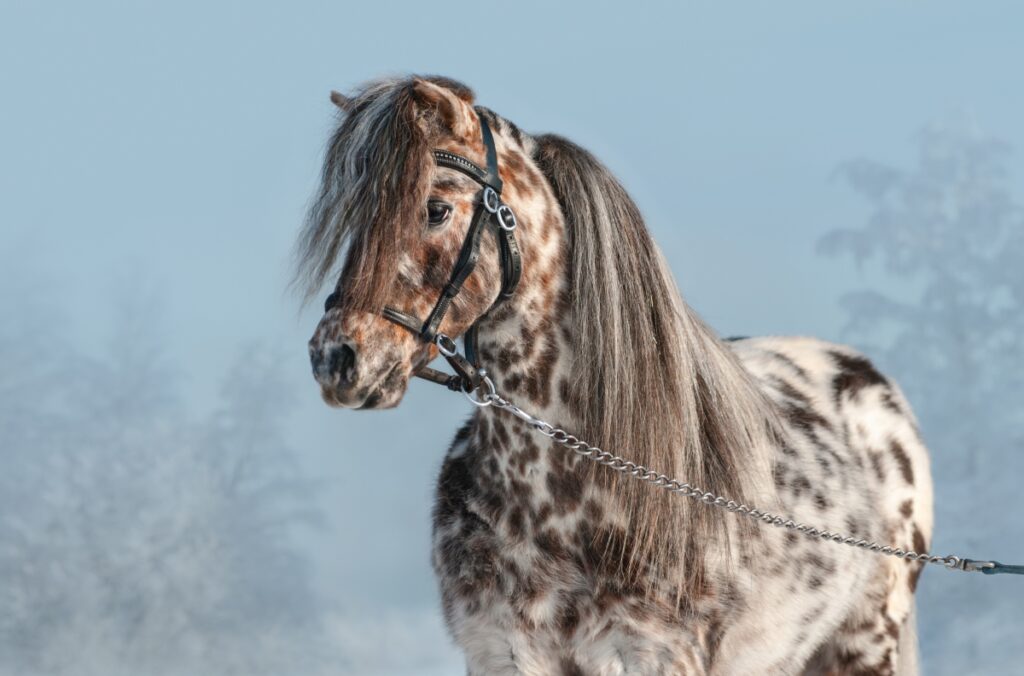
Knabstruppers
The Knabstrupper originated in Denmark in the 19th century. The breed was popular as a circus horse, but in the early 20th century interest in the breed diminished and the breeding of these spotted horses almost died out. In the 1970s, breeding was re-established but in Denmark, the country of origin, only about 200 foals are born each year. There are different types of Knabstruppers, they can vary from almost completely white horses to horses with various spotted patterns to horses with completely solid colors.

Photo: “File:Danish Knabstrupper – Xantos.jpg” by Melyni at English Wikipedia is licensed under CC BY-SA 3.0.:
Pony of the Americas – POA
When the breeding of POAs started in the 1950s, the goal was “The head was to be small and dished as the Arab; the body was to be muscled as the Quarter Horse; and the coloring had to be Appaloosa, visible at 40 feet.” According to the breed standard, the horses should be beautiful and symmetrical with a neck height of between 46 and 56 inches as an adult. Only spotted colors are allowed. The breed is bred to be a good children’s pony and should be suited for equine sport i.e. trail and endurance riding, ranch work, and hunting.
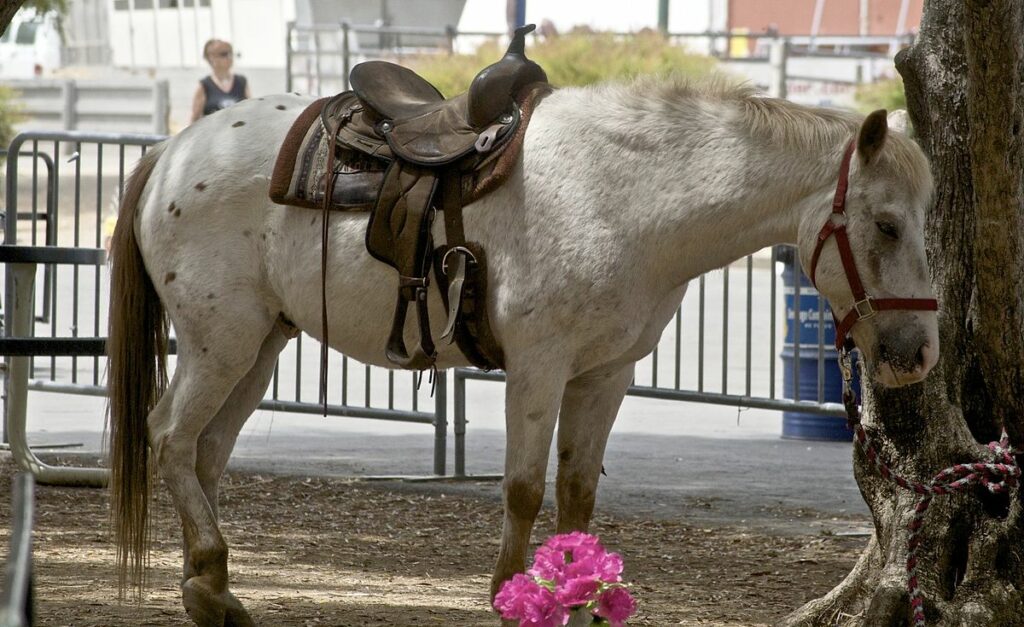
Photo: Pony of the Americas. is licensed under CC BY 2.0
In Wikipedia. https://en.wikipedia.org/wiki/Pony_of_the_Americas
Gypsy Cobs an Gypsy Vanners
During the First World War, many horses and ponies in Britain were purchased by the army for use in war service. The only type of horse that the army was not interested in was the colored horse as it was more difficult to camouflage in wartime situations. The Romany gypsies then took the opportunity to specialize in breeding these colored and spotted horses so that they could keep them out of the army, the race Gypsy cob was born. Originally the Gypsy Cob was designed to transport Romany Gypsy families and their wagons around England and Ireland. According to the breeding club in England, the horse is today known to be one of the most honest, hard-working, and gentle breeds of horse in the world. In the U.S. they are called Gypsy Vanners.
Mustang
Leopard complexes occur in Spanish mustangs but are not very common.
Welsh
According to the Welsh Pony and Cob Society, any color except skewbald and piebald (colored horses) is allowed. The Society was formed in 1901 but the Welsh pony itself is believed to have existed for over a thousand years in the Welsh mountains. There are different types of Welsh here ranked from smallest to tallest:
-Welsh Mountain Pony (Section A)
– Welsh Pony (Section B)
– Welsh Pony of Cob Type (Section C)
– Welsh Cob (Section D) Welsh ponies and cobs are known for their good temperament and hardiness but are also noble as they are very much influenced by Arabian horses.
British spotted pony
A breed with only spotted ponies in different varieties. Exists in three different sizes
- miniature ponies – 107 cm (42 inches and smaller)
- riding ponies
- cobs up to 14.2 hh
The ponies must have any or all of the following appearances:
- white sclera around the eye
- mottled skin
- striped hooves (vertical)
Colorado ranger
The Colorado Ranger is a western horse breed that originated in the colorado high plains. The founder of the Colorado Ranger breed decided that a horse’s ability does not depend on its color; therefore, all colors including spotted are allowed
Felin pony
The Felin pony is a Polish breed that has been shown to have a Leopard complex, and thus spotted horses, according to a 2002 study.
Noriker horse
The Noriker is an Austrian cold-blooded horse with several different colors including spotted.

Photo: Paula Jantunen, Public domain, via Wikimedia Commons
https://commons.wikimedia.org/wiki/File:Spotted_Noriker_horse.JPG
Falabella
Leopard complex is quite common in the Falabella breed. The Falabella is a small breed between 28 and 34 in withers. The breed originates from Argentina.
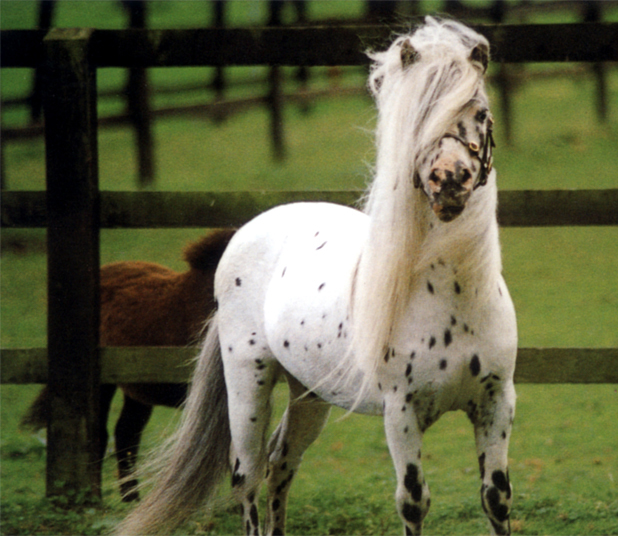
Photo: Captain E H Eckholdt, Attribution, via Wikimedia Commons
https://commons.wikimedia.org/wiki/File:FalabellaFestivo.jpg
Gotland pony
Swedish breed of pony type. The spotted color exists in the breed but is uncommon.
Spanish Spotted Saddle Horse
The Spanish Spotted Saddle Horse is a medium-sized saddle horse, similar in type to the baroque PRE horse, i.e. with a noble character, great movements combined with spottedness, and a lot of mane and tail.
Altai
The Altai horse originates from the Altai Mountains of Central Asia and is well adapted to the harsh environment.
Kyrgyzstan horse
The Kyrgyz Horse or Kirgiz Horse is a small horse breed from Kyrgyzstan. Some people think they are the original appaloosas (see the video trailer below).
Australian Spotted Pony
Australian Spotted Ponies are a spotted pony breed from Australia that must be under 14hh.
Tuva Horse
Tuva horse is a very old breed originating from the Siberian region. Researchers found evidence from 800 BC of a leopard-spotted horse in the Tuva region.
Tiger Horse
An ancient breed that may have been the predecessor of the Appaloosa. Called Caballo Tigre or Tiger Horses. The special feature of this breed, apart from the points, is its fourth gait. It is a four-beat, medium-paced gait that has also been called the “Indian shuffle”. Today there is a conservation association and the horses must meet the following criteria to be registered:
- Leopard complex color
- an even four beat intermediate gait
- at least some Spanish conformation characteristics
The horses registered in the Tiger Horse Association can be Appaloosa breed, Spanish mustang, Paso breed, American native herds, wild horse herds, or rare Spanish breeds ex Florida Cracker Horse.
Andalusian and Lucitano
Leopard complex is rare in these two breeds. However, spotted horses were more common in these breeds in the past.
Paso Fino, Paso Tiger Horse or Atrigado Spanish Jennet Horse
The breed have the additional four-beat gait. To be registered in Spanish Jennet Horse, the horse must be at least 50% Paso or Paso Fino blood. Spotted horses are registered in the Atrigado division of the association.
Walkaloosa
Walkaloosa is a mix between Tennessee Walking Horse and Appaloosa. The horses have the typical gait of the Tennessee Walking Horse and the typical spots of the Appaloosa.
Karabair horses
A small and fast riding horse originating from Uzbekistan. One of the oldest horse breeds in Central Asia.
South German Coldblood
South German Coldblood is the Bavarian equivalent of the Austrian Noriker. In the breed the Leopard complex is confirmed but it is quite rare.
Breeds not allowed to be spotted but have the Leopard complex anyway
According to studies, the Leopard complex LP gene is found in several different breeds including breeds that do not accept spotted horses.
Shetland Ponies
Small strong pony from the Shetland Islands of Scotland originally used in the coal mines where they pulled wagons full of coal. Not to exceed 42 inches (107cm) in height. According to the British Shetland pony breeder society, Shetland ponies may be any color except spotted. However, the above study showed that several Shetland ponies carried the leopard gene but should not be included as a spotted horse breed according to the breed regulations.
American Quarter Horses
According to the American Quarter Horse Association, the quarter horse can have one of the following 23 colors: chestnut, sorrel, black, brown, gray, bay, palomino, buckskin, smoky black, smoky cream, cremello, perlino, white, classic champagne, amber champagne, gold champagne, dun, red dun, grullo, red roan, bay roan, brown roan, and blue roan. That is, spotted is not included as an allowed color but the leopard gene is still found in quarter horses in the study.
Tennessee Walking Horses
According to the Tennessee Walking Horse Breeders’ and Exhibitors’ Association (TWHBEA), spotted horses are not listed as an approved color. Despite this, the leopard complex is present in the breed.
American Paint Horse
The Leopard complex is prohibited in the breed. Tabiano and overo patterns are the most common colors in the breed.
Spotted Horse in different languages
| Language | Term for Spotted/Leopard Horse |
|---|---|
| English U.S | Appaloosa color or Leopard |
| English UK | Spotted |
| French | Tacheté |
| German | Leopard-gemusterten |
Disadvantages of spotted horses
Congenital Stationary Night Blindness (CSNB)
There is one disadvantage of spotted horses that you should consider if you are buying your own horse or breeding spotted horses and that is that a particular eye disease Congenital Stationary Night Blindness (CSNB) has been linked to the Leopard complex. Horses with a double set of the leopard gene have been shown to suffer from this disease as seen in appaloosas for example. The disease leads to poor vision in the dark and at dusk/dawn.
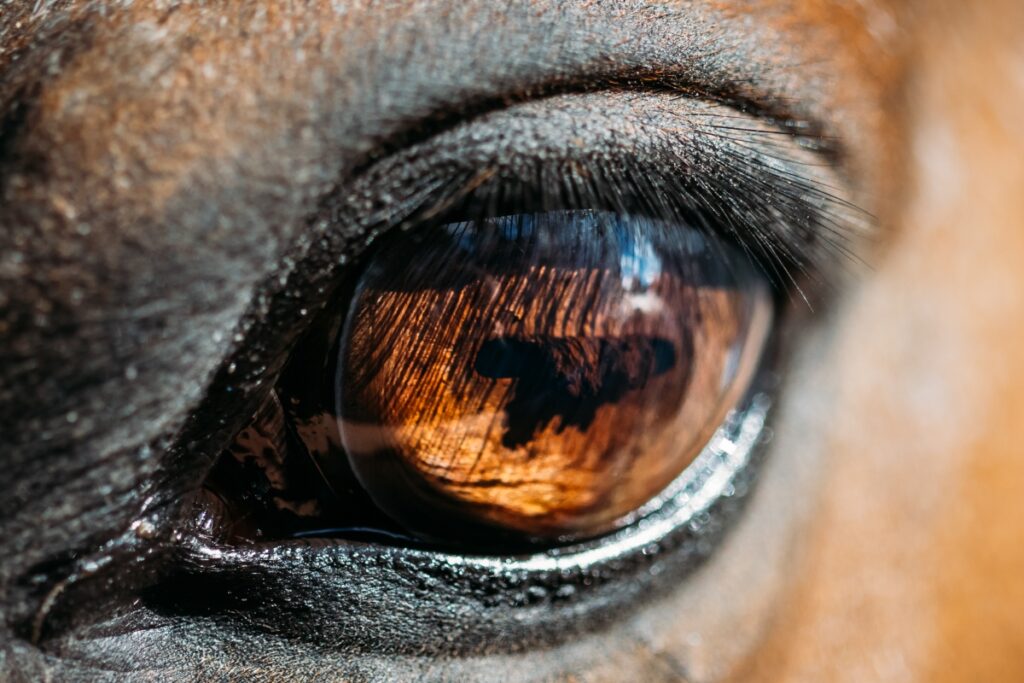
Inbreeding
As some of the spotted breeds are very rare and with few individuals, there is a risk of inbreeding. This should be considered and avoided when breeding.
Conclusion
Researchers found evidence for the long-term existence of the leopard complex spotted phenotype in the European horse population, they believe some of the very old cave paintings with spotted horses might be a true picture of then-existing leopard-spotted horses. So the beautiful horse with spots has existed for a long time and the color is now existing in many different breeds. I hope this article was helpful and that you learned a lot about spotted horse breeds.
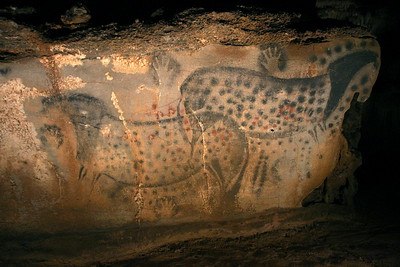
Photo: Claude Valette is licensed under CC BY 2.0
Sources
Avila, F.; Hughes, S.S.; Magdesian, K.G.; Penedo, M.C.T.; Bellone, R.R. Breed Distribution and Allele Frequencies of Base Coat Color, Dilution, and White Patterning Variants across 28 Horse Breeds. Genes 2022, 13, 1641. https://doi.org/10.3390/genes13091641
Stachurska, Anna, Anne P. Ussing, and Ryszard Kolstrung. “Tobiano and leopard alleles in felin pony population.” Electronic Journal of Polish Agricultural Universities. Series Animal Husbandry 5.1 (2002).
Grilz‐Seger, G., et al. “Analysis of ROH patterns in the Noriker horse breed reveals signatures of selection for coat color and body size.” Animal genetics 50.4 (2019): 334-346.
Pruvost, Melanie, et al. “Genotypes of predomestic horses match phenotypes painted in Paleolithic works of cave art.” Proceedings of the National Academy of Sciences 108.46 (2011): 18626-18630.
Ludwig A, Reissmann M, Benecke N, Bellone R, Sandoval-Castellanos E, Cieslak M, Fortes GG, Morales-Muñiz A, Hofreiter M, Pruvost M. Twenty-five thousand years of fluctuating selection on leopard complex spotting and congenital night blindness in horses. Philos Trans R Soc Lond B Biol Sci. 2015 Jan 19;370(1660):20130386. doi: 10.1098/rstb.2013.0386. PMID: 25487337; PMCID: PMC4275893.
D. P. Sponenberg, G. Carr, E. Simak, K. Schwink, The Inheritance of the Leopard Complex of Spotting Patterns in Horses, Journal of Heredity, Volume 81, Issue 4, July 1990, Pages 323–331, https://doi.org/10.1093/oxfordjournals.jhered.a110997
https://www.amha.org/ The American Miniature Horse Association
https://www.tgca.co.uk/ TRADITIONAL GYPSY COB ASSOCIATION
https://www.shetlandponystudbooksociety.co.uk/ The Shetland Pony Stud-Book Society
https://www.aqha.com/ American Quarter Horse Association
https://twhbea.com/ Tennessee Walking Horse Breeders’ and Exhibitors’ Association (TWHBEA)
https://www.appaloosaproject.co/
https://wpcs.uk.com/ Welsh Pony and Cob Society
https://bapsh.co.uk/spanish-spotted-saddle-horse/
https://www.britishspottedponysociety.co.uk/
http://www.coloradoranger.com/
http://afs.okstate.edu/breeds/horses/altai/index.html/
https://imh.org/exhibits/past/breeds-of-the-world/north-america/tiger-horse/
http://www.falabellafmha.com/ Falabella Miniature Horse Association (FMHA)
http://www.spanishjennethorses.org/atigrado.html https://www.poac.org/ Pony Of the Americas Club

